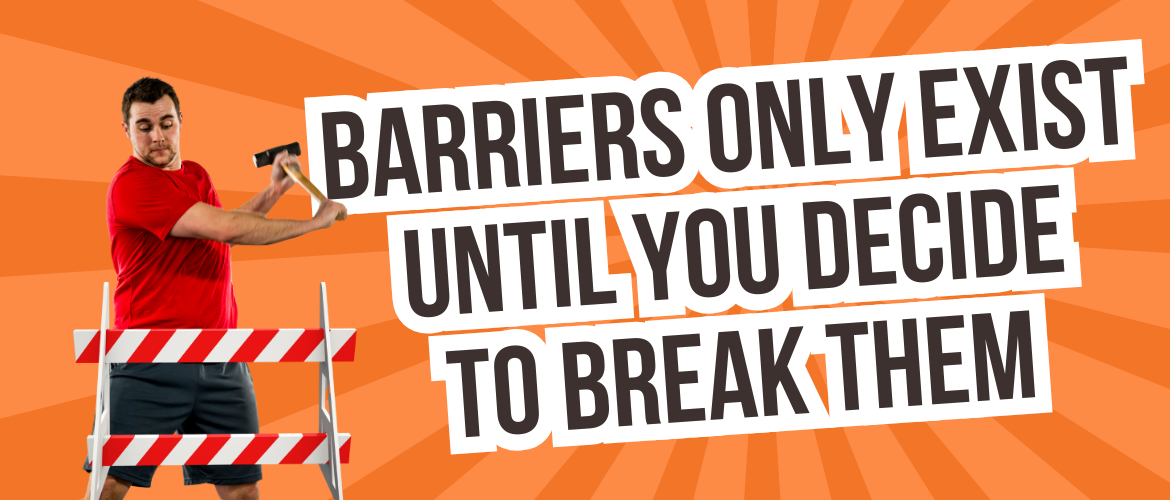GET IN TOUCH TODAY!
"*" indicates required fields

Whether you’re a gym instructor, personal trainer, or strength and conditioning coach, one of the biggest challenges you’ll face isn’t writing great programmes—it’s helping clients stick to them.
Even the most effective plan fails without consistency. And consistency only comes when we understand what stops people from exercising and how to remove those barriers.
The ability to recognise and address these challenges is what separates an average coach from a great one. It builds trust, drives results, and helps clients turn exercise from a chore into a habit that lasts a lifetime.
Before you can help clients move forward, you need to understand what’s holding them back. Barriers can be physical, psychological, social, or environmental. Here are the most common examples seen across all fitness settings:
1. Lack of Time
Busy work schedules, family commitments, or study pressures can make exercise feel impossible to prioritise.
2. Low Confidence or Motivation
Some clients feel anxious in fitness environments or believe they’re not “fit enough” to start. Others lose motivation when progress slows or life gets busy.
3. Financial Constraints
Cost can be a genuine concern. Memberships, coaching, and travel to facilities can all feel like barriers.
4. Limited Access or Environment
Not everyone enjoys or feels comfortable in a traditional gym. Others may lack transport or suitable spaces to train.
5. Injury or Health Conditions
Fear of aggravating an injury or uncertainty about what’s safe to do can stop people from training altogether.
6. Lack of Enjoyment
If sessions feel repetitive or disconnected from personal goals, enthusiasm fades fast.
7. Social or Cultural Factors
Lack of support from friends or family, or cultural expectations, can also make sticking to exercise harder.
Every client’s circumstances are unique—but every barrier can be overcome with the right coaching approach.
One of the most effective ways to improve adherence is to build programmes that reflect the client’s preferences and values.
When people enjoy the process, they’re far more likely to stick with it. Giving clients autonomy—some control over the way they train—creates ownership and commitment.
Here’s how to make that happen:
Ask, don’t assume. Use consultations to explore what types of activity they enjoy or have done before.
Keep it varied. Rotate training styles and environments to maintain excitement.
Give choice. Allow clients to help shape their programme—it’s their journey.
Make it meaningful. Connect training goals to something that matters personally, such as playing with their kids, feeling confident, or improving their well-being.
When clients feel understood and involved, motivation becomes natural.
Motivation thrives when progress is recognised. Rewards don’t always have to be physical or financial—they can be emotional, social, or achievement-based.
Effective approaches include:
Tracking Progress: Regularly measure performance, health markers, or attendance to make progress visible.
Celebrating Milestones: Recognise consistency, new personal bests, or completing a training phase.
Gamifying Training: Introduce mini challenges or streak systems to keep things fun.
Highlighting Effort: Praise effort as much as outcomes—celebrating commitment builds confidence.
Focusing on Intrinsic Rewards: Help clients connect training to how it makes them feel—stronger, calmer, more energised.
Small wins, consistently celebrated, create long-term adherence.
Understanding barriers is only step one. Real impact comes from applying strategies that turn obstacles into opportunities.
Here are practical, evidence-based methods every fitness professional can use:
1. Set SMART Goals
Work with clients to create Specific, Measurable, Achievable, Realistic, and Time-bound goals. Clear targets give structure, direction, and a sense of achievement.
2. Start Small and Build Confidence
Begin with manageable steps. Early success creates belief and momentum.
3. Reframe Limiting Beliefs
Challenge all-or-nothing thinking. Remind clients that progress isn’t about perfection—it’s about consistency.
4. Teach Time Efficiency
Show clients how to get great results with short, focused sessions. Circuits, supersets, or time-based formats make exercise achievable in busy schedules.
5. Strengthen Social Support
Encourage training with friends, joining small groups, or sharing goals. Social accountability improves adherence.
6. Educate and Reassure
Help clients understand safe progression, recovery, and how to work around injuries. Reducing fear increases confidence.
7. Apply Behaviour Change Techniques
Use motivational interviewing, reflection, and regular feedback to build intrinsic motivation.
8. Create a Positive Environment
Clients stay where they feel welcomed, encouraged, and valued. Your attitude and energy set the tone.
9. Offer Flexibility
Adapt plans when life changes. Providing options for home or outdoor sessions prevents setbacks from becoming excuses.
10. Review and Adjust Regularly
Monitor progress, celebrate wins, and make changes where needed. A dynamic plan keeps clients engaged.
Helping someone overcome barriers isn’t about discipline—it’s about design.
It’s about listening to their story, understanding their life, and creating a structure that fits it. The best fitness professionals don’t just prescribe—they collaborate, motivate, and adapt.
When clients see that you care about why they struggle as much as how they train, you build trust that lasts far beyond the gym floor.
Great coaches know that success isn’t built on sets and reps alone—it’s built on empathy, understanding, and communication.
Whether you’re guiding a new gym member, supporting a client through a long-term goal, or coaching an athlete through performance phases, the same principle applies:
Listen first, then lead.
When clients feel seen, heard, and supported, adherence stops being a battle—it becomes a partnership.
Apply This Knowledge:
Reflect on your current clients—what barriers are holding them back, and what small adjustments could make the biggest difference?
Subscribe to Our Blog & Podcast:
Get weekly insights designed to help fitness professionals strengthen motivation, improve results, and grow their careers.
Advance Your Coaching Skills with Storm Fitness Academy:
Whether you’re just starting out or ready to take your expertise to the next level, we offer recognised qualifications that develop both your technical knowledge and your coaching psychology.
Fill out the contact form below if you’d like friendly, no-obligation advice on the best path for your career.
"*" indicates required fields